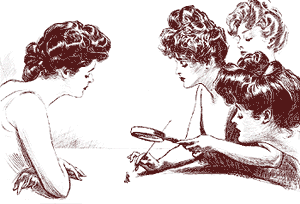39c. Women in the Gilded Age

The idea was to create a maternal commonwealth. Upper-middle-class women of the late 19th century were not content with the cult of domesticity of the early 1800s. Many had become college educated and yearned to put their knowledge and skills to work for the public good.
Maternal commonwealth meant just that. The values of women's sphere — caretaking, piety, purity — would be taken out of the home and placed in the public life. The result was a broad reform movement that transformed America.
Just Say No to Alcohol
Many educated women of the age felt that many of society's greatest disorders could be traced to alcohol. According to their view, alcohol led to increased domestic violence and neglect. It decreased the income families could spend on necessities and promoted prostitution and adultery. In short, prohibition of alcohol might diminish some of these maladies.
Frances Willard was the president of the Woman's Christian Temperance Union, the nation's foremost prohibition organization. Although national prohibition was not enacted until 1919, the WCTU was successful at pressuring state and local governments to pass dry laws. Willard advocated a "Do Everything" policy, which meant that chapters of the WCTU also served as soup kitchens or medical clinics.
The WCTU worked within the system, but there were radical temperance advocates who did not. Carry Nation preferred the direct approach of taking an ax into saloons and chopping the bars to pieces.
Homes for the Destitute
Another way women promoted the values of women's sphere into the public arena was through the settlement house movement. A settlement house was a home where destitute immigrants could go when they had nowhere else to turn. Settlement houses provided family-style cooking, lessons in English, and tips on how to adapt to American culture.
The first settlement house began in 1889 in Chicago and was called Hull House. Its organizer, Jane Addams, intended Hull House to serve as a prototype for other settlement houses. By 1900 there were nearly 100 settlement houses in the nation's cities. Jane Addams was considered the founder of a new profession — social work.
Different Backgrounds, Different Lives
Most of the advocates of maternal commonwealth were white, upper-middle-class women. Many of these women had received a college education and felt obliged to put it to use. About half of the women in this demographic group never married, choosing instead independence. Other college educated women were content to join literary clubs to keep academic pursuits alive.
For women who did not attend college, life was much different. Many single, middle-class women took jobs in the new cities. Clerical jobs opened as typewriters became indispensable to the modern corporation. The telephone service required switchboard operators and the new department store required sales positions. Many of these women found themselves feeling marvelously independent, despite the lower wages they were paid in comparison with their male counterparts.
For others, life was less glamorous. Wives of immigrants often took extra tenants called boarders into their already crowded tenement homes. By providing food and laundry service at a fee, they generated necessary extra income for the families. Many did domestic work for the middle class to supplement income.
In the South, the lives of wealthy women changed from managing a home on a slave plantation to one with hired work. Women who found themselves with new freedom from slavery still suffered great difficulties. Sharecropping was a male and female task. Women in these conditions found themselves doing double duty by working the fields by day and the house by night.







